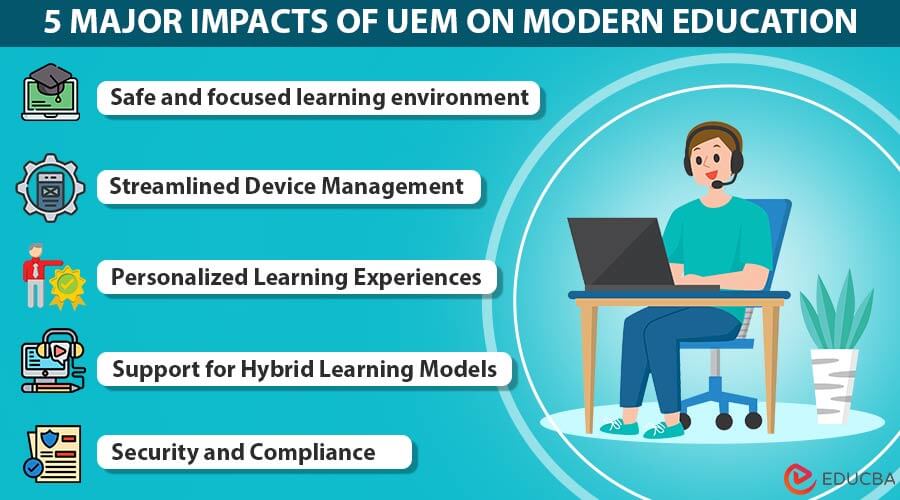5 Major Impacts of UEM on Modern Education
As educational institutions worldwide adopt digital teaching and learning platforms, technology plays a crucial role in facilitating this shift. It has reshaped the traditional teaching methodologies and has transformed the modern education industry. This has led to an increase in the number of devices, such as tablets, laptops, interactive displays, etc., involved in the learning and teaching process.
Yet, as the device usage increases, so does the complexity of managing them. This is where Unified Endpoint Management comes into play, offering a centralized platform to manage, monitor, and secure educational devices and providing students with a safe and concentrated learning environment.
Here are 5 major impacts of UEM that have transformed the management and security posture in the modern education industry:
1. Safe and focused learning environment
With students gaining access to various devices for studying, educational institutions must control student devices to provide them with a safe and focused learning environment. Students must not access inappropriate apps and websites to ensure a productive learning experience.
UEM enables content filtering, allowing administrators to restrict access to specific websites and content. It also comes with various features such as app whitelisting/blacklisting and kiosk mode. These features give institutions fine-grained control over applications that can be installed and run on devices. Kiosk mode locks devices into single or multi-app mode, turning them into dedicated learning tools.
While single-app mode is excellent for focused learning, there are instances where students need to access multiple educational applications simultaneously. Multi-app mode enables students to access multiple applications within a controlled environment. This enhances the quality and control of the overall educational environment.
2. Streamlined Device Management
Unified endpoint management provides streamlined device enrollment and configuration. It makes it easier for educational institutions to set up and prepare devices such as tablets, laptops, and Interactive Flat Panel Displays (IFPDs) for classroom use. With centralized management capability, IT teams gain all-in-one control over diverse endpoints and devices within an integrated platform. This simplifies administrative tasks for IT admins and allows them to perform bulk actions such as enrollment, software updates, pushing new applications, and applying security policies before the device even reaches the classroom.
These features and setup ensure that all devices are ready for immediate use, reducing downtime and enhancing the teaching and learning experience. UEM platforms enhance connectivity and enable the remote monitoring of device, app, data, and storage usage across the entire device inventory.
When any device issue occurs, admins can remotely troubleshoot any managed device, preventing disruptions in learning. With UEM, you can customize settings and policies to meet specific educational requirements. IT administrators can tailor configurations that align with the institution’s educational goals.
3. Personalized Learning Experiences
Unlike traditional rote learning, the modern education industry has transitioned toward personalized learning. It is essential for students to have a personalized learning experience, which will prevent academic burnout. This will increase their productivity and enable them to gain better focus.
UEM emphasizes personalized learning by allowing educational institutions to push content to devices as per student needs. For example, a student struggling with math can receive additional math apps or tools, while a student excelling in science can be provided with advanced science resources.
In addition, many UEM platforms offer geofence-based profile switching. IT admins can manage profiles that will be applied to a device upon entering and leaving a geofence, irrespective of the current device profile. You can grant apps access to data when the device enters a secure geofence and revoke access when the device leaves the geofence.
4. Support for Hybrid Learning Models
UEM plays a crucial role in supporting hybrid learning models, which combine in-person and remote instruction. It provides a unified framework for communication, collaboration, and content delivery. This bridges the gap between physical and virtual classrooms, enabling seamless management and continuity in the educational experience.
Moreover, with UEM’s scalability, educational institutions can easily manage a shift from short to large device inventory without any disruption in management. It enables the IT team of a school or educational institution to withstand such major change.
5. Security and Compliance
With digital learning environments taking center stage, data security and privacy are crucial for educational institutions. Educational institutions cannot afford sensitive data breaches. To address such issues, UEM offers robust features, such as compliance monitoring, to safeguard sensitive information and protect against cyber threats, ensuring compliance with regulatory standards and bolstering trust in educational systems.
If a device is stolen or lost, UEM enables IT admins to locate, remotely lock, and wipe it. This prevents student data from falling into the wrong hands.
IT admins can set device compliance, which the students should adhere to. For instance, an educational institution implements UEM to ensure that all student devices comply with security standards. The UEM solution checks each device to ensure that antivirus software is installed and regularly updated. If a student’s device does not have the latest antivirus updates, admins get a notification and can restrict access to certain school resources until the device is compliant. This ensures that all devices used within the school network are secure, protecting both the students’ data and the school’s IT infrastructure from potential threats.
Final Words
The modern education industry revolves around personalized learning and student empowerment without compromising security, privacy, and safety. A comprehensive unified endpoint management (UEM) solution covers all the critical aspects of today’s digitized learning. From managing various fleets of devices to OS such as Android, Windows, iOS, and macOS, UEM enhances the quality, efficiency, and security of digital environments, ultimately leading to a more effective and inclusive learning experience.


